University Name: Decision Making Process Analysis Report
VerifiedAdded on 2022/08/14
|27
|5526
|17
Report
AI Summary
This report provides a comprehensive analysis of the decision-making process, focusing on the application of analytical tools and techniques. The report begins by defining decision-making and discussing its importance, along with the application of decision analysis. It then identifies and outlines a decision problem involving multiple objectives, using the scenario of selecting a dream house in Malaysia as a business case. The report delves into the Single Multi-Attribute Rating Technique (SMART), detailing its application and steps involved, and discussing its strengths and limitations in the context of the decision problem. The report also explores various DM tools such as decision matrix, decision tree, and T-charts. The report concludes with a discussion of the limitations and strengths of the analysis, providing valuable insights into the complexities of decision-making and the effectiveness of different analytical approaches. The report also includes an introduction, table of contents, and references.
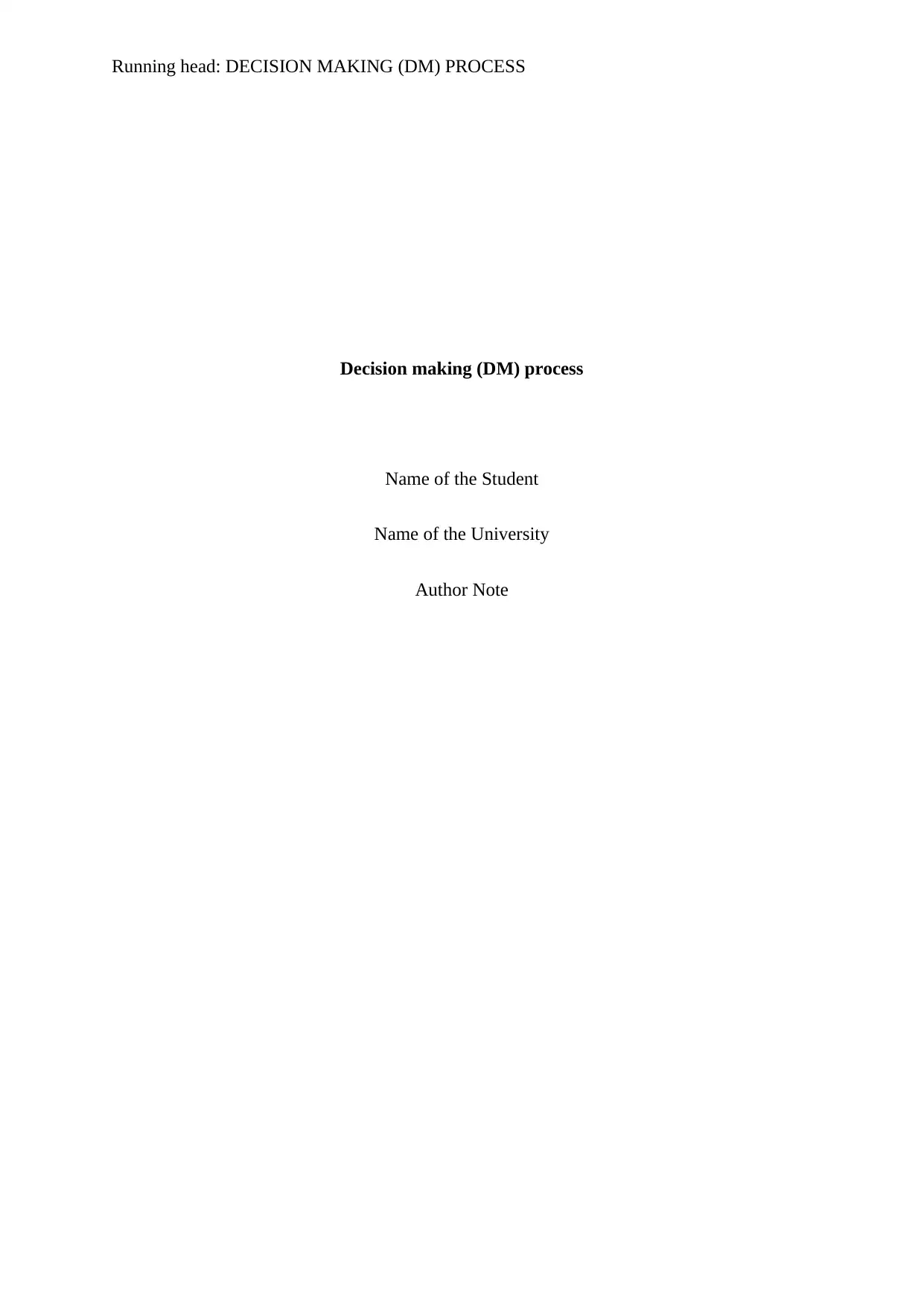
Running head: DECISION MAKING (DM) PROCESS
Decision making (DM) process
Name of the Student
Name of the University
Author Note
Decision making (DM) process
Name of the Student
Name of the University
Author Note
Paraphrase This Document
Need a fresh take? Get an instant paraphrase of this document with our AI Paraphraser
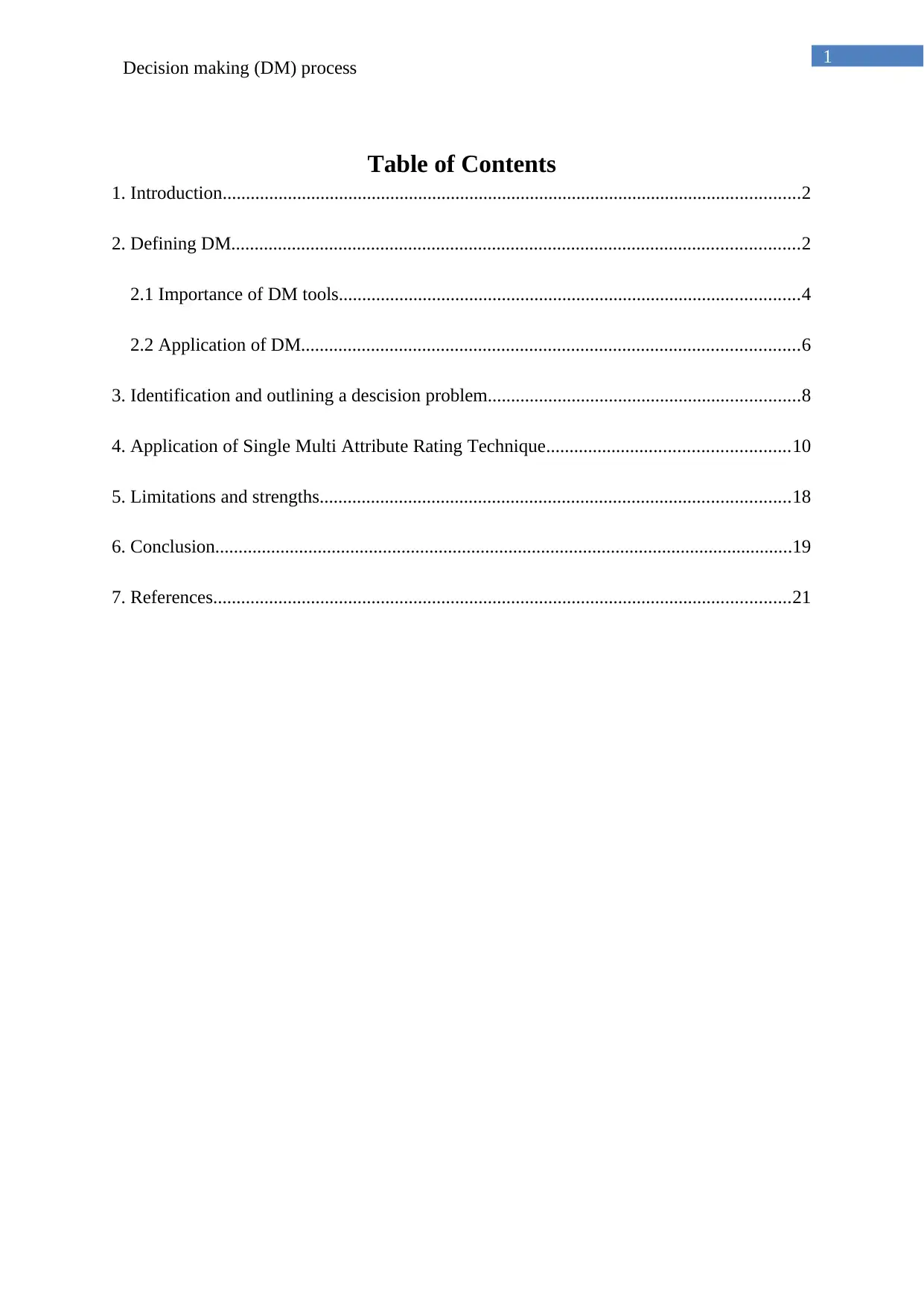
Decision making (DM) process 1
Table of Contents
1. Introduction............................................................................................................................2
2. Defining DM..........................................................................................................................2
2.1 Importance of DM tools...................................................................................................4
2.2 Application of DM...........................................................................................................6
3. Identification and outlining a descision problem...................................................................8
4. Application of Single Multi Attribute Rating Technique....................................................10
5. Limitations and strengths.....................................................................................................18
6. Conclusion............................................................................................................................19
7. References............................................................................................................................21
Table of Contents
1. Introduction............................................................................................................................2
2. Defining DM..........................................................................................................................2
2.1 Importance of DM tools...................................................................................................4
2.2 Application of DM...........................................................................................................6
3. Identification and outlining a descision problem...................................................................8
4. Application of Single Multi Attribute Rating Technique....................................................10
5. Limitations and strengths.....................................................................................................18
6. Conclusion............................................................................................................................19
7. References............................................................................................................................21
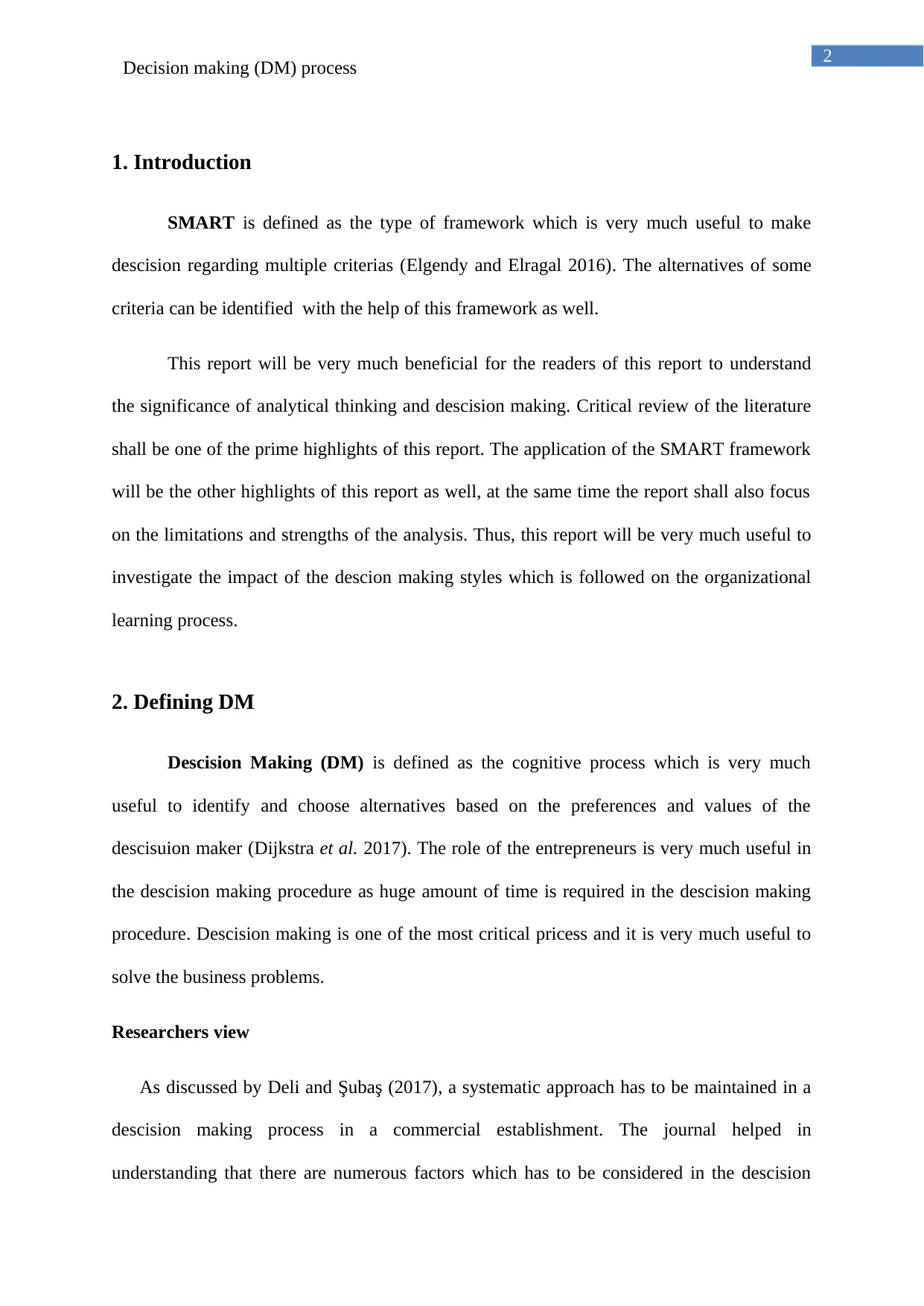
2
Decision making (DM) process
1. Introduction
SMART is defined as the type of framework which is very much useful to make
descision regarding multiple criterias (Elgendy and Elragal 2016). The alternatives of some
criteria can be identified with the help of this framework as well.
This report will be very much beneficial for the readers of this report to understand
the significance of analytical thinking and descision making. Critical review of the literature
shall be one of the prime highlights of this report. The application of the SMART framework
will be the other highlights of this report as well, at the same time the report shall also focus
on the limitations and strengths of the analysis. Thus, this report will be very much useful to
investigate the impact of the descion making styles which is followed on the organizational
learning process.
2. Defining DM
Descision Making (DM) is defined as the cognitive process which is very much
useful to identify and choose alternatives based on the preferences and values of the
descisuion maker (Dijkstra et al. 2017). The role of the entrepreneurs is very much useful in
the descision making procedure as huge amount of time is required in the descision making
procedure. Descision making is one of the most critical pricess and it is very much useful to
solve the business problems.
Researchers view
As discussed by Deli and Şubaş (2017), a systematic approach has to be maintained in a
descision making process in a commercial establishment. The journal helped in
understanding that there are numerous factors which has to be considered in the descision
Decision making (DM) process
1. Introduction
SMART is defined as the type of framework which is very much useful to make
descision regarding multiple criterias (Elgendy and Elragal 2016). The alternatives of some
criteria can be identified with the help of this framework as well.
This report will be very much beneficial for the readers of this report to understand
the significance of analytical thinking and descision making. Critical review of the literature
shall be one of the prime highlights of this report. The application of the SMART framework
will be the other highlights of this report as well, at the same time the report shall also focus
on the limitations and strengths of the analysis. Thus, this report will be very much useful to
investigate the impact of the descion making styles which is followed on the organizational
learning process.
2. Defining DM
Descision Making (DM) is defined as the cognitive process which is very much
useful to identify and choose alternatives based on the preferences and values of the
descisuion maker (Dijkstra et al. 2017). The role of the entrepreneurs is very much useful in
the descision making procedure as huge amount of time is required in the descision making
procedure. Descision making is one of the most critical pricess and it is very much useful to
solve the business problems.
Researchers view
As discussed by Deli and Şubaş (2017), a systematic approach has to be maintained in a
descision making process in a commercial establishment. The journal helped in
understanding that there are numerous factors which has to be considered in the descision
⊘ This is a preview!⊘
Do you want full access?
Subscribe today to unlock all pages.

Trusted by 1+ million students worldwide
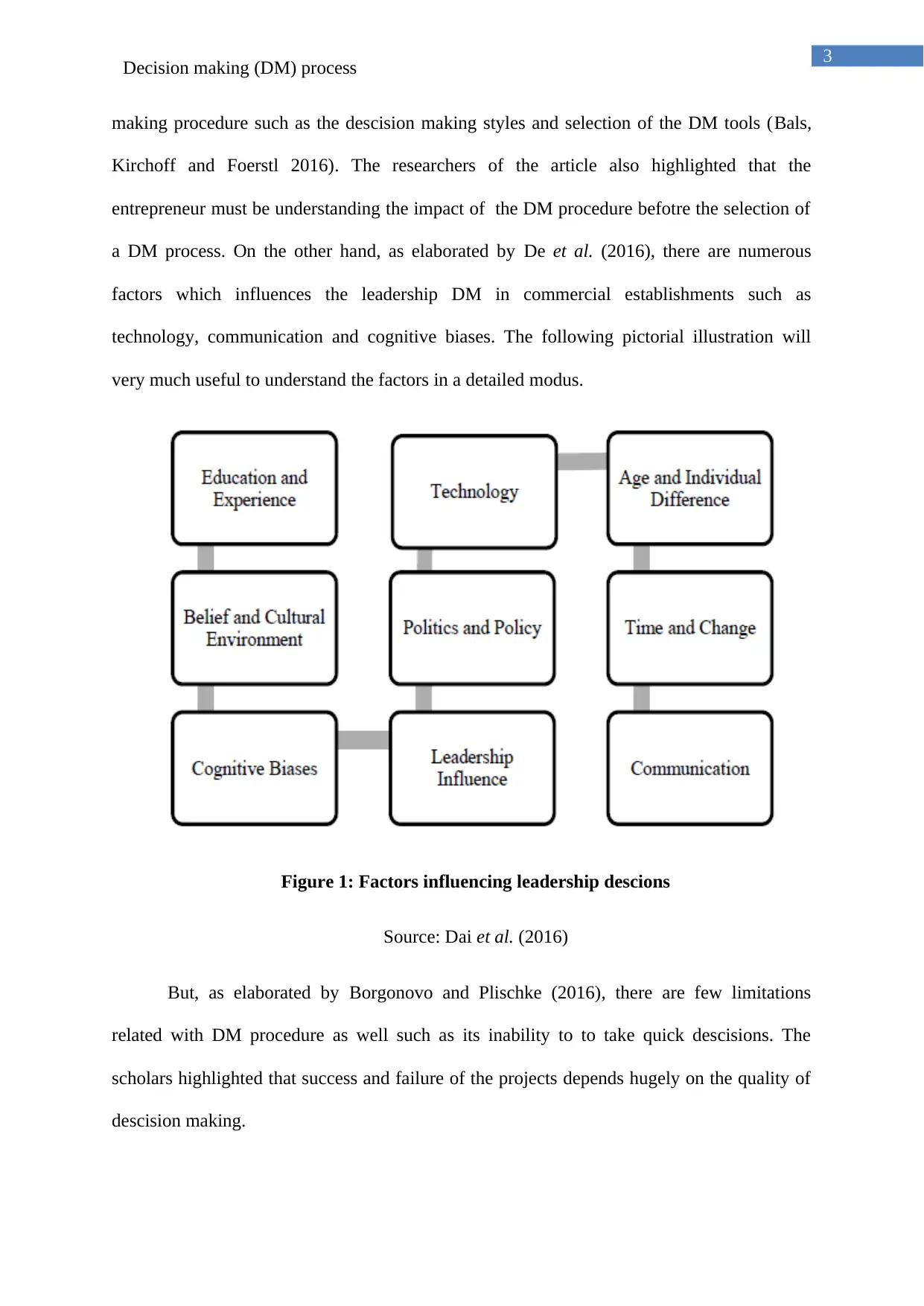
3
Decision making (DM) process
making procedure such as the descision making styles and selection of the DM tools (Bals,
Kirchoff and Foerstl 2016). The researchers of the article also highlighted that the
entrepreneur must be understanding the impact of the DM procedure befotre the selection of
a DM process. On the other hand, as elaborated by De et al. (2016), there are numerous
factors which influences the leadership DM in commercial establishments such as
technology, communication and cognitive biases. The following pictorial illustration will
very much useful to understand the factors in a detailed modus.
Figure 1: Factors influencing leadership descions
Source: Dai et al. (2016)
But, as elaborated by Borgonovo and Plischke (2016), there are few limitations
related with DM procedure as well such as its inability to to take quick descisions. The
scholars highlighted that success and failure of the projects depends hugely on the quality of
descision making.
Decision making (DM) process
making procedure such as the descision making styles and selection of the DM tools (Bals,
Kirchoff and Foerstl 2016). The researchers of the article also highlighted that the
entrepreneur must be understanding the impact of the DM procedure befotre the selection of
a DM process. On the other hand, as elaborated by De et al. (2016), there are numerous
factors which influences the leadership DM in commercial establishments such as
technology, communication and cognitive biases. The following pictorial illustration will
very much useful to understand the factors in a detailed modus.
Figure 1: Factors influencing leadership descions
Source: Dai et al. (2016)
But, as elaborated by Borgonovo and Plischke (2016), there are few limitations
related with DM procedure as well such as its inability to to take quick descisions. The
scholars highlighted that success and failure of the projects depends hugely on the quality of
descision making.
Paraphrase This Document
Need a fresh take? Get an instant paraphrase of this document with our AI Paraphraser
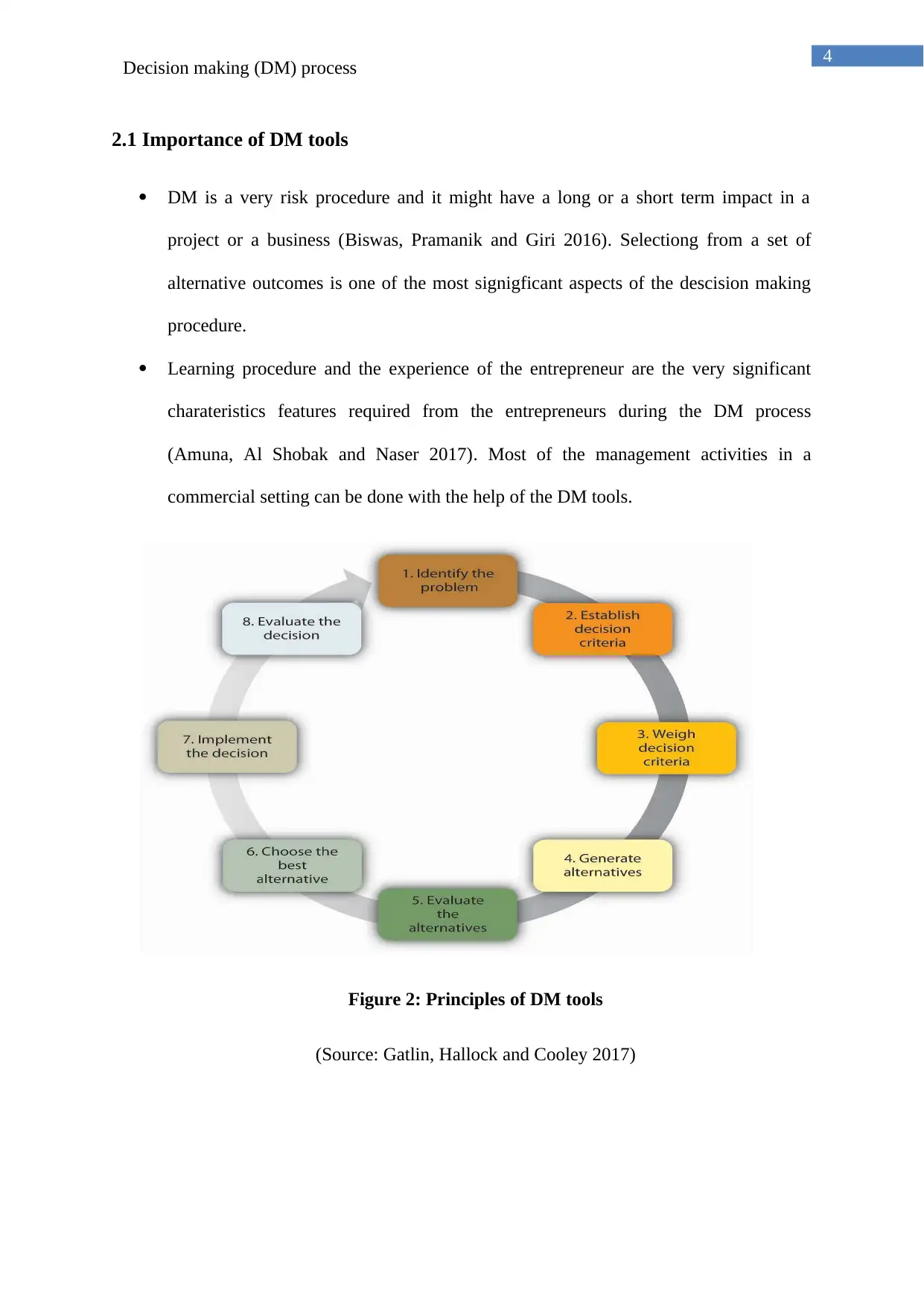
4
Decision making (DM) process
2.1 Importance of DM tools
DM is a very risk procedure and it might have a long or a short term impact in a
project or a business (Biswas, Pramanik and Giri 2016). Selectiong from a set of
alternative outcomes is one of the most signigficant aspects of the descision making
procedure.
Learning procedure and the experience of the entrepreneur are the very significant
charateristics features required from the entrepreneurs during the DM process
(Amuna, Al Shobak and Naser 2017). Most of the management activities in a
commercial setting can be done with the help of the DM tools.
Figure 2: Principles of DM tools
(Source: Gatlin, Hallock and Cooley 2017)
Decision making (DM) process
2.1 Importance of DM tools
DM is a very risk procedure and it might have a long or a short term impact in a
project or a business (Biswas, Pramanik and Giri 2016). Selectiong from a set of
alternative outcomes is one of the most signigficant aspects of the descision making
procedure.
Learning procedure and the experience of the entrepreneur are the very significant
charateristics features required from the entrepreneurs during the DM process
(Amuna, Al Shobak and Naser 2017). Most of the management activities in a
commercial setting can be done with the help of the DM tools.
Figure 2: Principles of DM tools
(Source: Gatlin, Hallock and Cooley 2017)
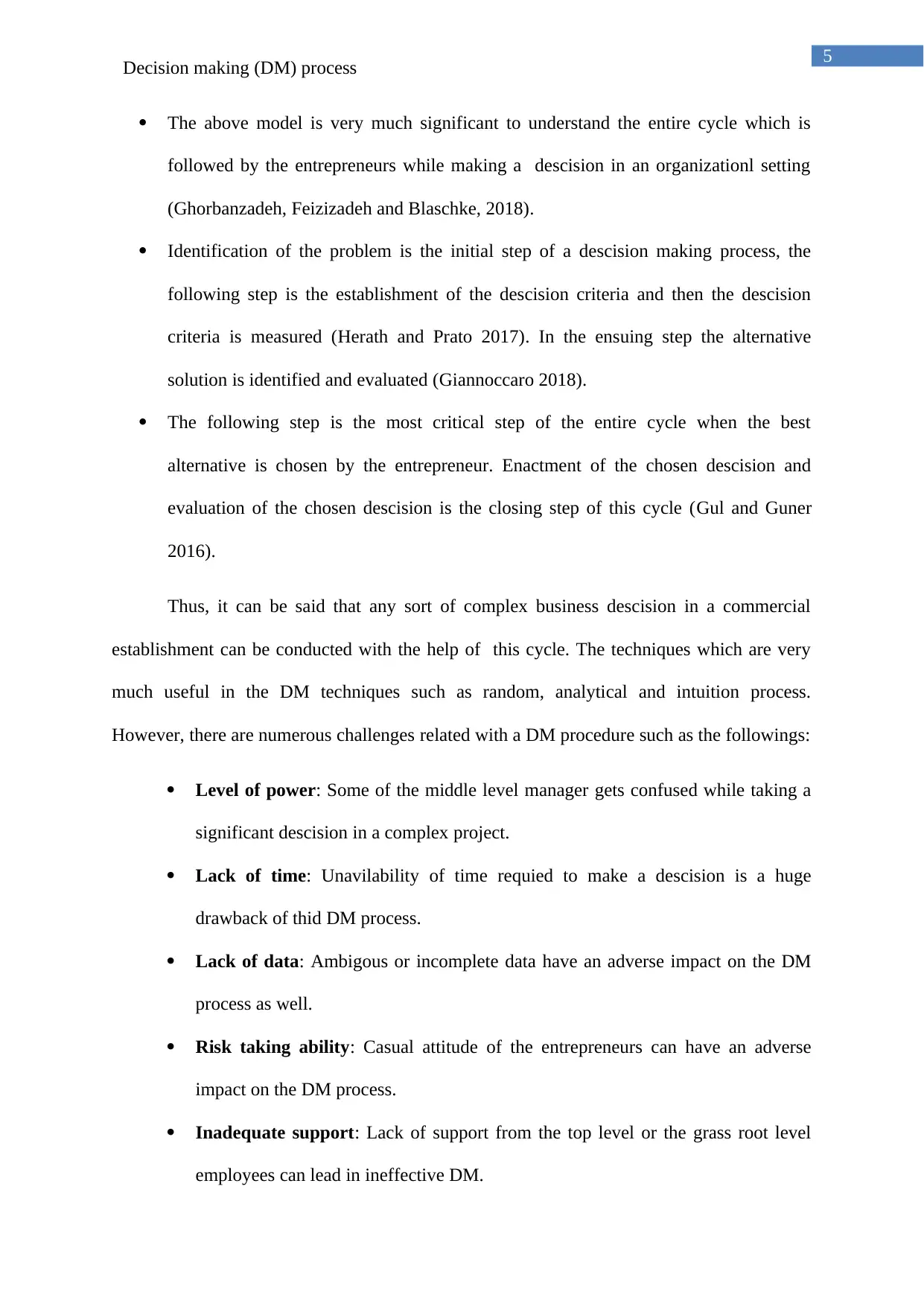
5
Decision making (DM) process
The above model is very much significant to understand the entire cycle which is
followed by the entrepreneurs while making a descision in an organizationl setting
(Ghorbanzadeh, Feizizadeh and Blaschke, 2018).
Identification of the problem is the initial step of a descision making process, the
following step is the establishment of the descision criteria and then the descision
criteria is measured (Herath and Prato 2017). In the ensuing step the alternative
solution is identified and evaluated (Giannoccaro 2018).
The following step is the most critical step of the entire cycle when the best
alternative is chosen by the entrepreneur. Enactment of the chosen descision and
evaluation of the chosen descision is the closing step of this cycle (Gul and Guner
2016).
Thus, it can be said that any sort of complex business descision in a commercial
establishment can be conducted with the help of this cycle. The techniques which are very
much useful in the DM techniques such as random, analytical and intuition process.
However, there are numerous challenges related with a DM procedure such as the followings:
Level of power: Some of the middle level manager gets confused while taking a
significant descision in a complex project.
Lack of time: Unavilability of time requied to make a descision is a huge
drawback of thid DM process.
Lack of data: Ambigous or incomplete data have an adverse impact on the DM
process as well.
Risk taking ability: Casual attitude of the entrepreneurs can have an adverse
impact on the DM process.
Inadequate support: Lack of support from the top level or the grass root level
employees can lead in ineffective DM.
Decision making (DM) process
The above model is very much significant to understand the entire cycle which is
followed by the entrepreneurs while making a descision in an organizationl setting
(Ghorbanzadeh, Feizizadeh and Blaschke, 2018).
Identification of the problem is the initial step of a descision making process, the
following step is the establishment of the descision criteria and then the descision
criteria is measured (Herath and Prato 2017). In the ensuing step the alternative
solution is identified and evaluated (Giannoccaro 2018).
The following step is the most critical step of the entire cycle when the best
alternative is chosen by the entrepreneur. Enactment of the chosen descision and
evaluation of the chosen descision is the closing step of this cycle (Gul and Guner
2016).
Thus, it can be said that any sort of complex business descision in a commercial
establishment can be conducted with the help of this cycle. The techniques which are very
much useful in the DM techniques such as random, analytical and intuition process.
However, there are numerous challenges related with a DM procedure such as the followings:
Level of power: Some of the middle level manager gets confused while taking a
significant descision in a complex project.
Lack of time: Unavilability of time requied to make a descision is a huge
drawback of thid DM process.
Lack of data: Ambigous or incomplete data have an adverse impact on the DM
process as well.
Risk taking ability: Casual attitude of the entrepreneurs can have an adverse
impact on the DM process.
Inadequate support: Lack of support from the top level or the grass root level
employees can lead in ineffective DM.
⊘ This is a preview!⊘
Do you want full access?
Subscribe today to unlock all pages.

Trusted by 1+ million students worldwide
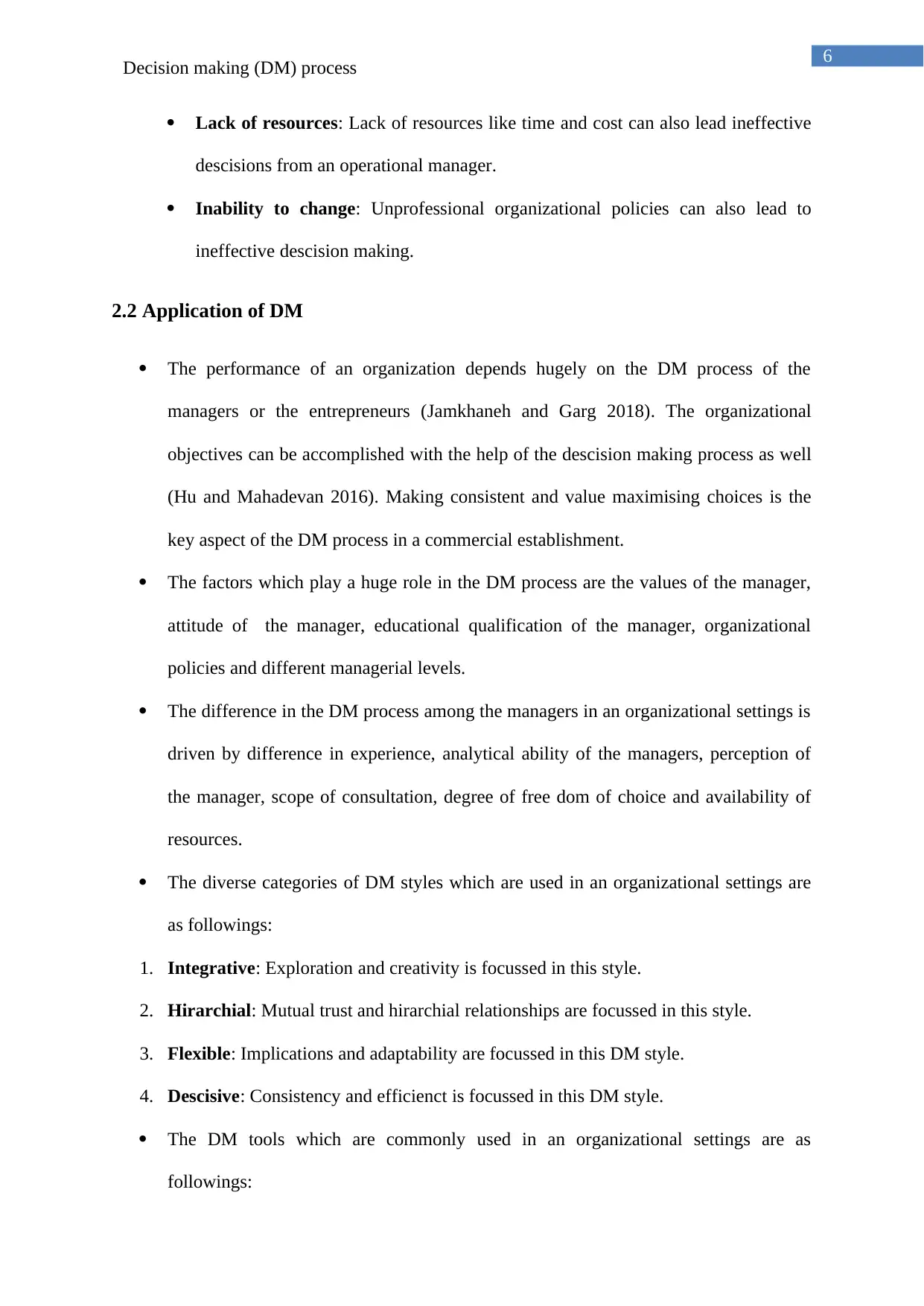
6
Decision making (DM) process
Lack of resources: Lack of resources like time and cost can also lead ineffective
descisions from an operational manager.
Inability to change: Unprofessional organizational policies can also lead to
ineffective descision making.
2.2 Application of DM
The performance of an organization depends hugely on the DM process of the
managers or the entrepreneurs (Jamkhaneh and Garg 2018). The organizational
objectives can be accomplished with the help of the descision making process as well
(Hu and Mahadevan 2016). Making consistent and value maximising choices is the
key aspect of the DM process in a commercial establishment.
The factors which play a huge role in the DM process are the values of the manager,
attitude of the manager, educational qualification of the manager, organizational
policies and different managerial levels.
The difference in the DM process among the managers in an organizational settings is
driven by difference in experience, analytical ability of the managers, perception of
the manager, scope of consultation, degree of free dom of choice and availability of
resources.
The diverse categories of DM styles which are used in an organizational settings are
as followings:
1. Integrative: Exploration and creativity is focussed in this style.
2. Hirarchial: Mutual trust and hirarchial relationships are focussed in this style.
3. Flexible: Implications and adaptability are focussed in this DM style.
4. Descisive: Consistency and efficienct is focussed in this DM style.
The DM tools which are commonly used in an organizational settings are as
followings:
Decision making (DM) process
Lack of resources: Lack of resources like time and cost can also lead ineffective
descisions from an operational manager.
Inability to change: Unprofessional organizational policies can also lead to
ineffective descision making.
2.2 Application of DM
The performance of an organization depends hugely on the DM process of the
managers or the entrepreneurs (Jamkhaneh and Garg 2018). The organizational
objectives can be accomplished with the help of the descision making process as well
(Hu and Mahadevan 2016). Making consistent and value maximising choices is the
key aspect of the DM process in a commercial establishment.
The factors which play a huge role in the DM process are the values of the manager,
attitude of the manager, educational qualification of the manager, organizational
policies and different managerial levels.
The difference in the DM process among the managers in an organizational settings is
driven by difference in experience, analytical ability of the managers, perception of
the manager, scope of consultation, degree of free dom of choice and availability of
resources.
The diverse categories of DM styles which are used in an organizational settings are
as followings:
1. Integrative: Exploration and creativity is focussed in this style.
2. Hirarchial: Mutual trust and hirarchial relationships are focussed in this style.
3. Flexible: Implications and adaptability are focussed in this DM style.
4. Descisive: Consistency and efficienct is focussed in this DM style.
The DM tools which are commonly used in an organizational settings are as
followings:
Paraphrase This Document
Need a fresh take? Get an instant paraphrase of this document with our AI Paraphraser
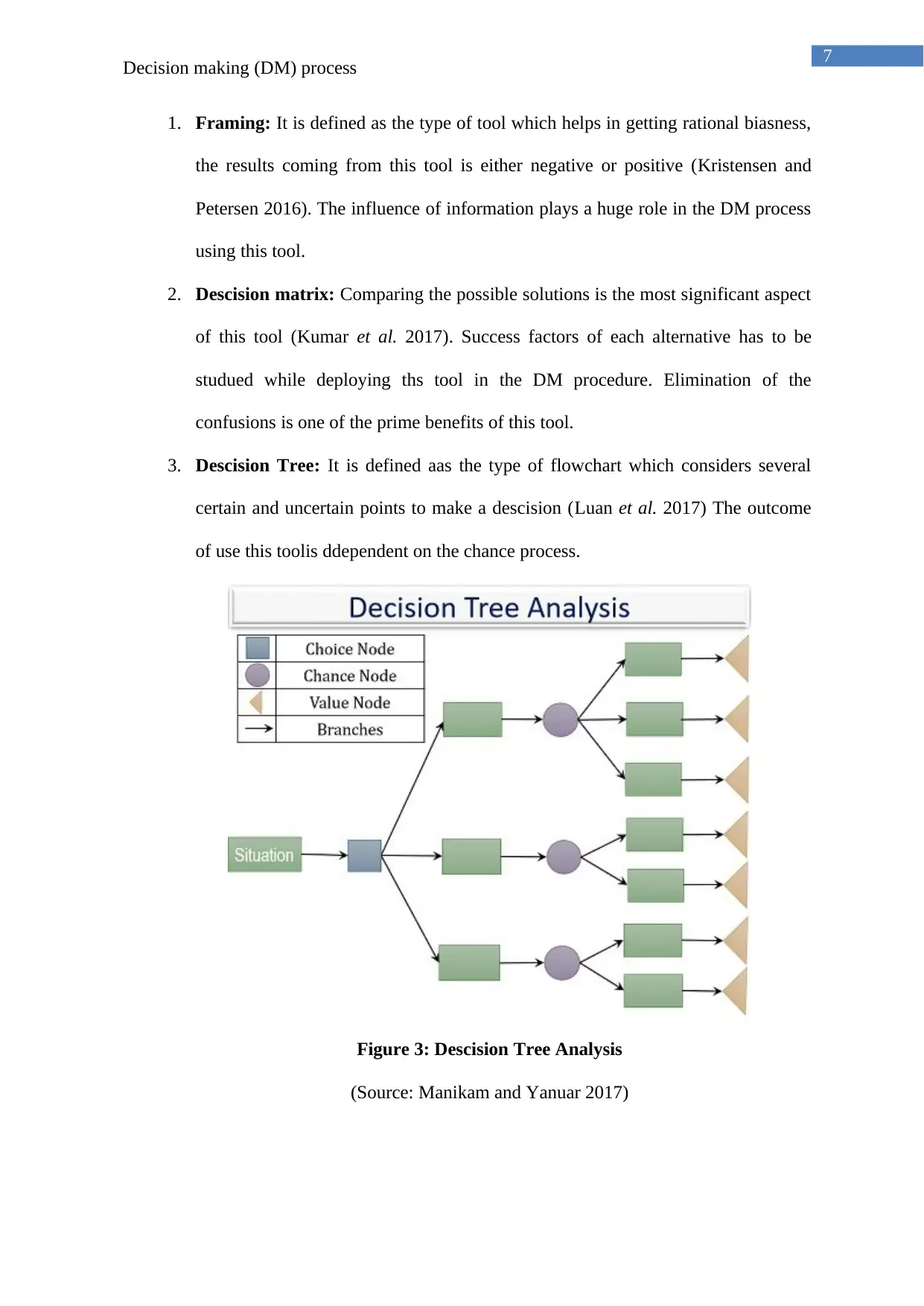
7
Decision making (DM) process
1. Framing: It is defined as the type of tool which helps in getting rational biasness,
the results coming from this tool is either negative or positive (Kristensen and
Petersen 2016). The influence of information plays a huge role in the DM process
using this tool.
2. Descision matrix: Comparing the possible solutions is the most significant aspect
of this tool (Kumar et al. 2017). Success factors of each alternative has to be
studued while deploying ths tool in the DM procedure. Elimination of the
confusions is one of the prime benefits of this tool.
3. Descision Tree: It is defined aas the type of flowchart which considers several
certain and uncertain points to make a descision (Luan et al. 2017) The outcome
of use this toolis ddependent on the chance process.
Figure 3: Descision Tree Analysis
(Source: Manikam and Yanuar 2017)
Decision making (DM) process
1. Framing: It is defined as the type of tool which helps in getting rational biasness,
the results coming from this tool is either negative or positive (Kristensen and
Petersen 2016). The influence of information plays a huge role in the DM process
using this tool.
2. Descision matrix: Comparing the possible solutions is the most significant aspect
of this tool (Kumar et al. 2017). Success factors of each alternative has to be
studued while deploying ths tool in the DM procedure. Elimination of the
confusions is one of the prime benefits of this tool.
3. Descision Tree: It is defined aas the type of flowchart which considers several
certain and uncertain points to make a descision (Luan et al. 2017) The outcome
of use this toolis ddependent on the chance process.
Figure 3: Descision Tree Analysis
(Source: Manikam and Yanuar 2017)
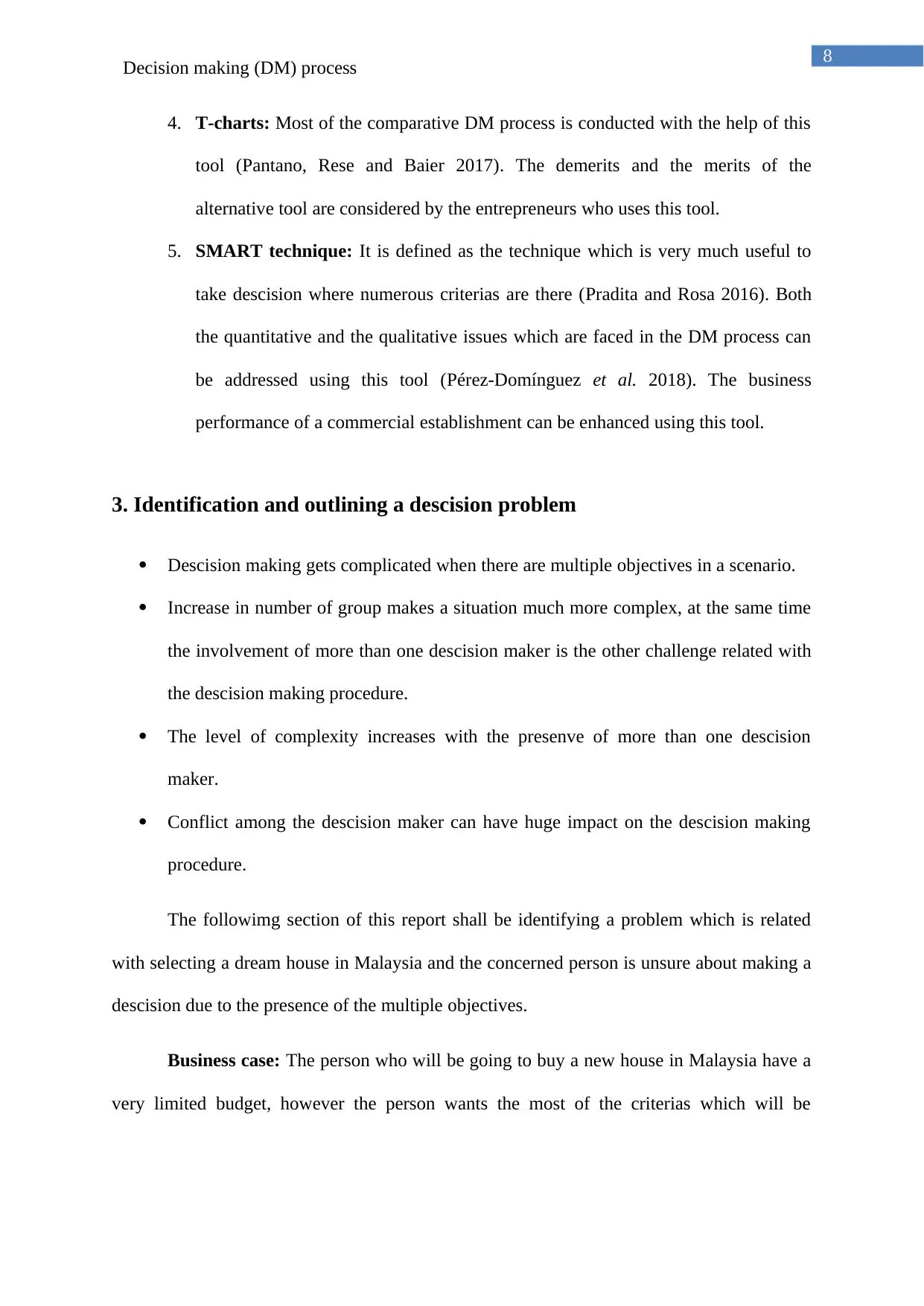
8
Decision making (DM) process
4. T-charts: Most of the comparative DM process is conducted with the help of this
tool (Pantano, Rese and Baier 2017). The demerits and the merits of the
alternative tool are considered by the entrepreneurs who uses this tool.
5. SMART technique: It is defined as the technique which is very much useful to
take descision where numerous criterias are there (Pradita and Rosa 2016). Both
the quantitative and the qualitative issues which are faced in the DM process can
be addressed using this tool (Pérez-Domínguez et al. 2018). The business
performance of a commercial establishment can be enhanced using this tool.
3. Identification and outlining a descision problem
Descision making gets complicated when there are multiple objectives in a scenario.
Increase in number of group makes a situation much more complex, at the same time
the involvement of more than one descision maker is the other challenge related with
the descision making procedure.
The level of complexity increases with the presenve of more than one descision
maker.
Conflict among the descision maker can have huge impact on the descision making
procedure.
The followimg section of this report shall be identifying a problem which is related
with selecting a dream house in Malaysia and the concerned person is unsure about making a
descision due to the presence of the multiple objectives.
Business case: The person who will be going to buy a new house in Malaysia have a
very limited budget, however the person wants the most of the criterias which will be
Decision making (DM) process
4. T-charts: Most of the comparative DM process is conducted with the help of this
tool (Pantano, Rese and Baier 2017). The demerits and the merits of the
alternative tool are considered by the entrepreneurs who uses this tool.
5. SMART technique: It is defined as the technique which is very much useful to
take descision where numerous criterias are there (Pradita and Rosa 2016). Both
the quantitative and the qualitative issues which are faced in the DM process can
be addressed using this tool (Pérez-Domínguez et al. 2018). The business
performance of a commercial establishment can be enhanced using this tool.
3. Identification and outlining a descision problem
Descision making gets complicated when there are multiple objectives in a scenario.
Increase in number of group makes a situation much more complex, at the same time
the involvement of more than one descision maker is the other challenge related with
the descision making procedure.
The level of complexity increases with the presenve of more than one descision
maker.
Conflict among the descision maker can have huge impact on the descision making
procedure.
The followimg section of this report shall be identifying a problem which is related
with selecting a dream house in Malaysia and the concerned person is unsure about making a
descision due to the presence of the multiple objectives.
Business case: The person who will be going to buy a new house in Malaysia have a
very limited budget, however the person wants the most of the criterias which will be
⊘ This is a preview!⊘
Do you want full access?
Subscribe today to unlock all pages.

Trusted by 1+ million students worldwide
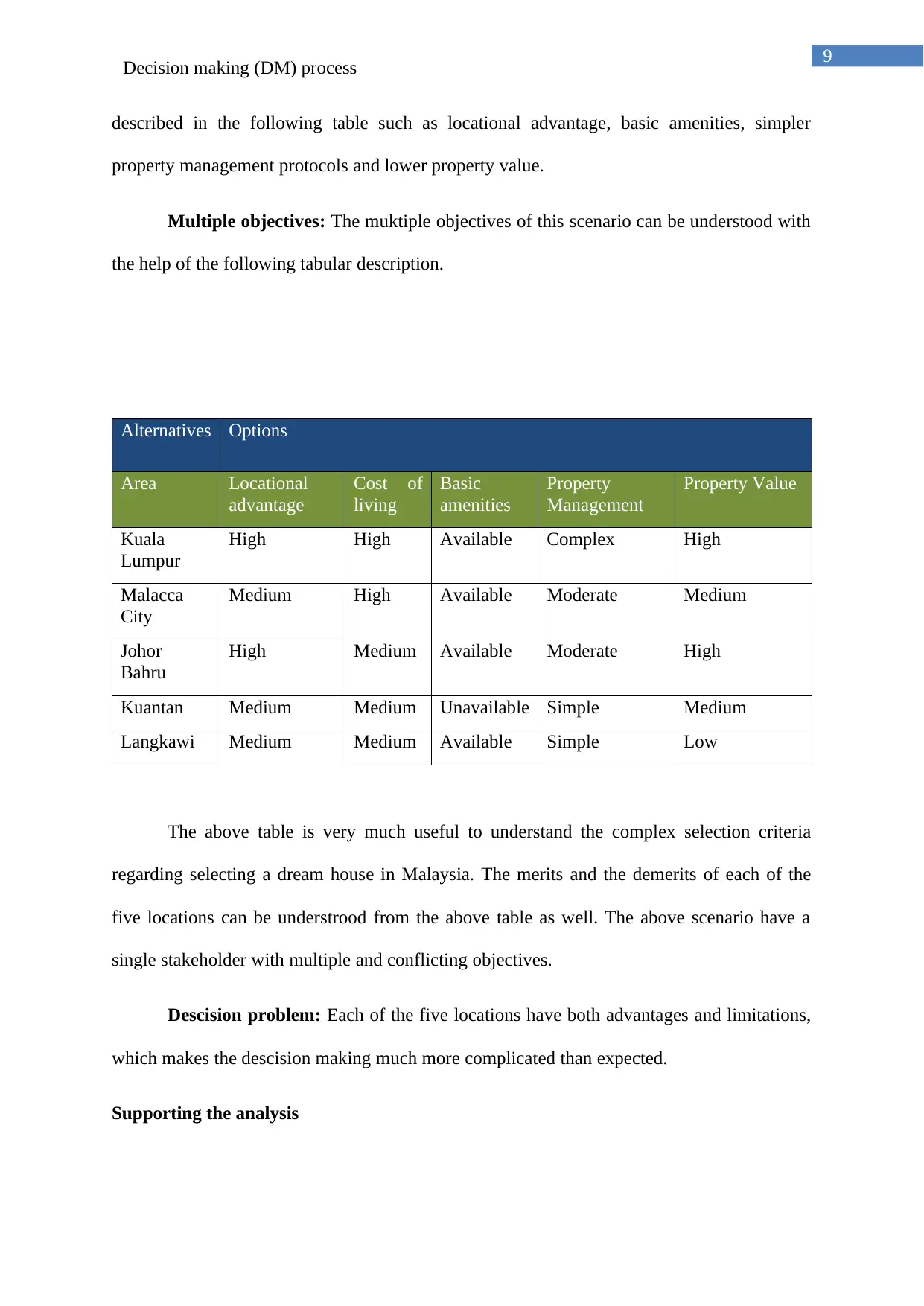
9
Decision making (DM) process
described in the following table such as locational advantage, basic amenities, simpler
property management protocols and lower property value.
Multiple objectives: The muktiple objectives of this scenario can be understood with
the help of the following tabular description.
Alternatives Options
Area Locational
advantage
Cost of
living
Basic
amenities
Property
Management
Property Value
Kuala
Lumpur
High High Available Complex High
Malacca
City
Medium High Available Moderate Medium
Johor
Bahru
High Medium Available Moderate High
Kuantan Medium Medium Unavailable Simple Medium
Langkawi Medium Medium Available Simple Low
The above table is very much useful to understand the complex selection criteria
regarding selecting a dream house in Malaysia. The merits and the demerits of each of the
five locations can be understrood from the above table as well. The above scenario have a
single stakeholder with multiple and conflicting objectives.
Descision problem: Each of the five locations have both advantages and limitations,
which makes the descision making much more complicated than expected.
Supporting the analysis
Decision making (DM) process
described in the following table such as locational advantage, basic amenities, simpler
property management protocols and lower property value.
Multiple objectives: The muktiple objectives of this scenario can be understood with
the help of the following tabular description.
Alternatives Options
Area Locational
advantage
Cost of
living
Basic
amenities
Property
Management
Property Value
Kuala
Lumpur
High High Available Complex High
Malacca
City
Medium High Available Moderate Medium
Johor
Bahru
High Medium Available Moderate High
Kuantan Medium Medium Unavailable Simple Medium
Langkawi Medium Medium Available Simple Low
The above table is very much useful to understand the complex selection criteria
regarding selecting a dream house in Malaysia. The merits and the demerits of each of the
five locations can be understrood from the above table as well. The above scenario have a
single stakeholder with multiple and conflicting objectives.
Descision problem: Each of the five locations have both advantages and limitations,
which makes the descision making much more complicated than expected.
Supporting the analysis
Paraphrase This Document
Need a fresh take? Get an instant paraphrase of this document with our AI Paraphraser
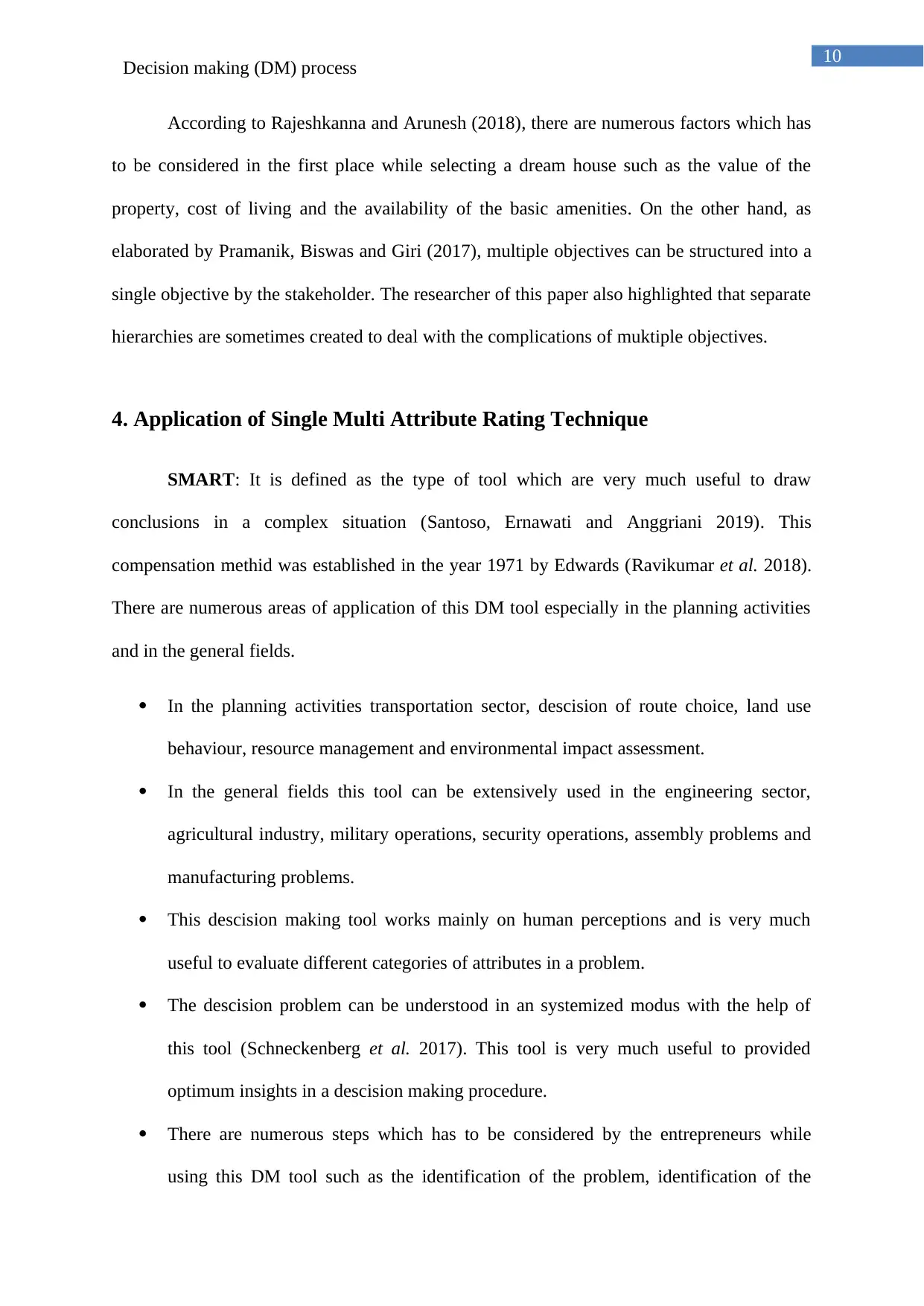
10
Decision making (DM) process
According to Rajeshkanna and Arunesh (2018), there are numerous factors which has
to be considered in the first place while selecting a dream house such as the value of the
property, cost of living and the availability of the basic amenities. On the other hand, as
elaborated by Pramanik, Biswas and Giri (2017), multiple objectives can be structured into a
single objective by the stakeholder. The researcher of this paper also highlighted that separate
hierarchies are sometimes created to deal with the complications of muktiple objectives.
4. Application of Single Multi Attribute Rating Technique
SMART: It is defined as the type of tool which are very much useful to draw
conclusions in a complex situation (Santoso, Ernawati and Anggriani 2019). This
compensation methid was established in the year 1971 by Edwards (Ravikumar et al. 2018).
There are numerous areas of application of this DM tool especially in the planning activities
and in the general fields.
In the planning activities transportation sector, descision of route choice, land use
behaviour, resource management and environmental impact assessment.
In the general fields this tool can be extensively used in the engineering sector,
agricultural industry, military operations, security operations, assembly problems and
manufacturing problems.
This descision making tool works mainly on human perceptions and is very much
useful to evaluate different categories of attributes in a problem.
The descision problem can be understood in an systemized modus with the help of
this tool (Schneckenberg et al. 2017). This tool is very much useful to provided
optimum insights in a descision making procedure.
There are numerous steps which has to be considered by the entrepreneurs while
using this DM tool such as the identification of the problem, identification of the
Decision making (DM) process
According to Rajeshkanna and Arunesh (2018), there are numerous factors which has
to be considered in the first place while selecting a dream house such as the value of the
property, cost of living and the availability of the basic amenities. On the other hand, as
elaborated by Pramanik, Biswas and Giri (2017), multiple objectives can be structured into a
single objective by the stakeholder. The researcher of this paper also highlighted that separate
hierarchies are sometimes created to deal with the complications of muktiple objectives.
4. Application of Single Multi Attribute Rating Technique
SMART: It is defined as the type of tool which are very much useful to draw
conclusions in a complex situation (Santoso, Ernawati and Anggriani 2019). This
compensation methid was established in the year 1971 by Edwards (Ravikumar et al. 2018).
There are numerous areas of application of this DM tool especially in the planning activities
and in the general fields.
In the planning activities transportation sector, descision of route choice, land use
behaviour, resource management and environmental impact assessment.
In the general fields this tool can be extensively used in the engineering sector,
agricultural industry, military operations, security operations, assembly problems and
manufacturing problems.
This descision making tool works mainly on human perceptions and is very much
useful to evaluate different categories of attributes in a problem.
The descision problem can be understood in an systemized modus with the help of
this tool (Schneckenberg et al. 2017). This tool is very much useful to provided
optimum insights in a descision making procedure.
There are numerous steps which has to be considered by the entrepreneurs while
using this DM tool such as the identification of the problem, identification of the
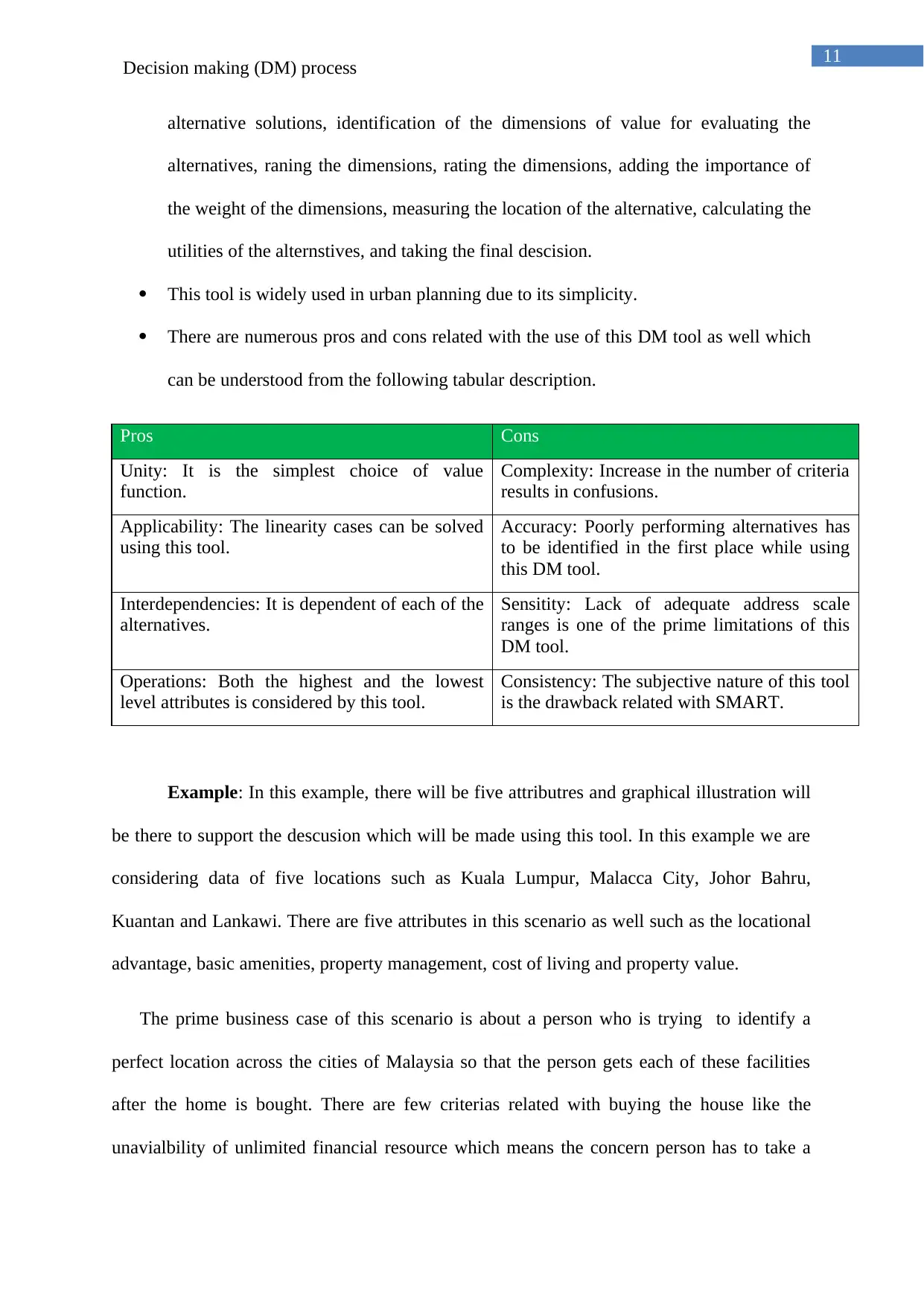
11
Decision making (DM) process
alternative solutions, identification of the dimensions of value for evaluating the
alternatives, raning the dimensions, rating the dimensions, adding the importance of
the weight of the dimensions, measuring the location of the alternative, calculating the
utilities of the alternstives, and taking the final descision.
This tool is widely used in urban planning due to its simplicity.
There are numerous pros and cons related with the use of this DM tool as well which
can be understood from the following tabular description.
Pros Cons
Unity: It is the simplest choice of value
function.
Complexity: Increase in the number of criteria
results in confusions.
Applicability: The linearity cases can be solved
using this tool.
Accuracy: Poorly performing alternatives has
to be identified in the first place while using
this DM tool.
Interdependencies: It is dependent of each of the
alternatives.
Sensitity: Lack of adequate address scale
ranges is one of the prime limitations of this
DM tool.
Operations: Both the highest and the lowest
level attributes is considered by this tool.
Consistency: The subjective nature of this tool
is the drawback related with SMART.
Example: In this example, there will be five attributres and graphical illustration will
be there to support the descusion which will be made using this tool. In this example we are
considering data of five locations such as Kuala Lumpur, Malacca City, Johor Bahru,
Kuantan and Lankawi. There are five attributes in this scenario as well such as the locational
advantage, basic amenities, property management, cost of living and property value.
The prime business case of this scenario is about a person who is trying to identify a
perfect location across the cities of Malaysia so that the person gets each of these facilities
after the home is bought. There are few criterias related with buying the house like the
unavialbility of unlimited financial resource which means the concern person has to take a
Decision making (DM) process
alternative solutions, identification of the dimensions of value for evaluating the
alternatives, raning the dimensions, rating the dimensions, adding the importance of
the weight of the dimensions, measuring the location of the alternative, calculating the
utilities of the alternstives, and taking the final descision.
This tool is widely used in urban planning due to its simplicity.
There are numerous pros and cons related with the use of this DM tool as well which
can be understood from the following tabular description.
Pros Cons
Unity: It is the simplest choice of value
function.
Complexity: Increase in the number of criteria
results in confusions.
Applicability: The linearity cases can be solved
using this tool.
Accuracy: Poorly performing alternatives has
to be identified in the first place while using
this DM tool.
Interdependencies: It is dependent of each of the
alternatives.
Sensitity: Lack of adequate address scale
ranges is one of the prime limitations of this
DM tool.
Operations: Both the highest and the lowest
level attributes is considered by this tool.
Consistency: The subjective nature of this tool
is the drawback related with SMART.
Example: In this example, there will be five attributres and graphical illustration will
be there to support the descusion which will be made using this tool. In this example we are
considering data of five locations such as Kuala Lumpur, Malacca City, Johor Bahru,
Kuantan and Lankawi. There are five attributes in this scenario as well such as the locational
advantage, basic amenities, property management, cost of living and property value.
The prime business case of this scenario is about a person who is trying to identify a
perfect location across the cities of Malaysia so that the person gets each of these facilities
after the home is bought. There are few criterias related with buying the house like the
unavialbility of unlimited financial resource which means the concern person has to take a
⊘ This is a preview!⊘
Do you want full access?
Subscribe today to unlock all pages.

Trusted by 1+ million students worldwide
1 out of 27
Related Documents
Your All-in-One AI-Powered Toolkit for Academic Success.
+13062052269
info@desklib.com
Available 24*7 on WhatsApp / Email
![[object Object]](/_next/static/media/star-bottom.7253800d.svg)
Unlock your academic potential
Copyright © 2020–2025 A2Z Services. All Rights Reserved. Developed and managed by ZUCOL.





